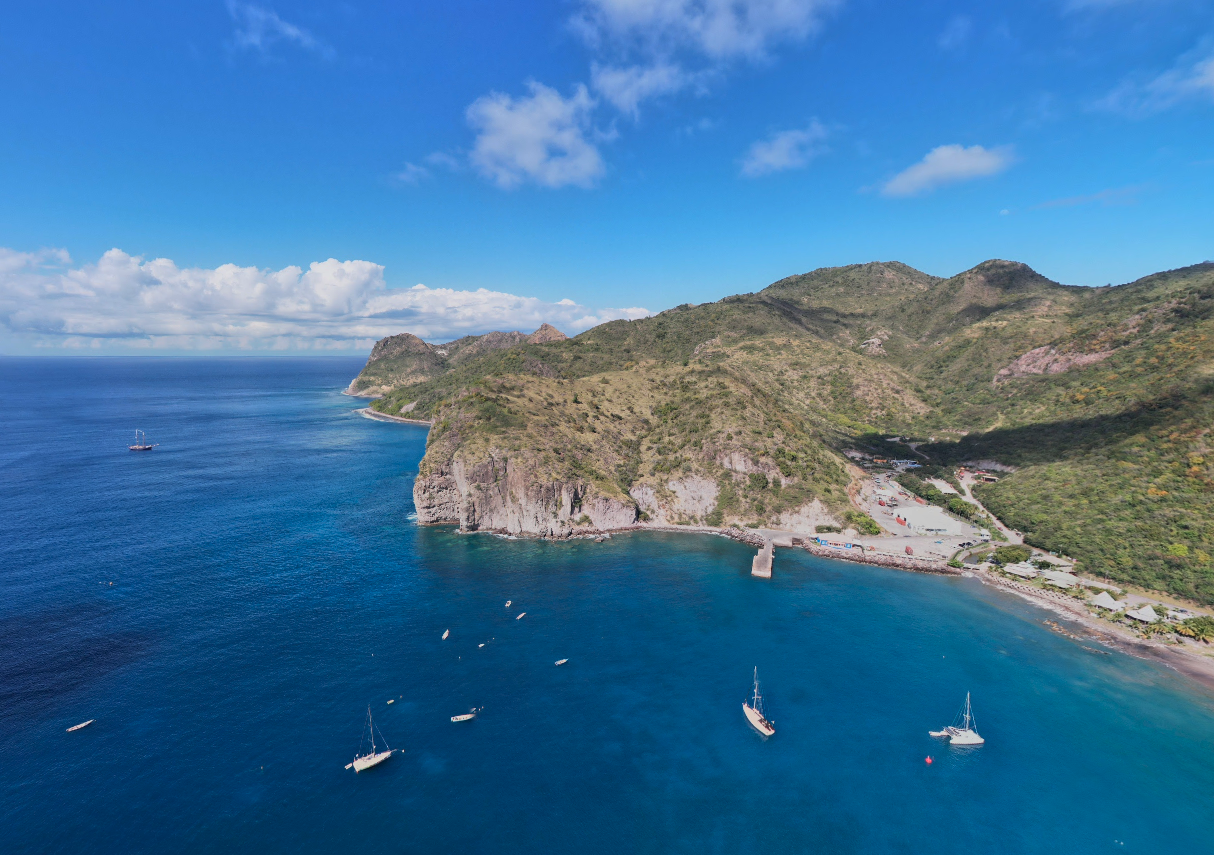Montserrat – Let’s explore here
What’s it like in Montserrat?
Montserrat is a volcanic island located in the Caribbean Sea in North America. As a British Overseas Territory, the British monarch is the head of state.
In 1995, the Soufrière Hills volcano started erupting and continued on-and-off until 2013. The original capital, Plymouth, was abandoned after the catastrophic damage caused by the volcano. Around half of the island to the south has currently been deemed an exclusion zone, which you cannot enter without a government-authorised guide (2024).
Around ⅔ of the population fled the island after the eruption, over ½ of whom went to the UK. It currently has a population of around 4,400 people (2022), about ¼ of whom live in the temporary capital city, Brades. The new capital city will be in Little Bay, close to Brades.
The island is around 10 miles (16 km) long and 7 miles (11 km) wide. It consists of a mostly mountainous landscape with some lovely beaches. Montserrat’s highest peak is the Soufrière Hills volcano, at 3,440 ft (1,050 m) above sea level.

A bit about the history of Montserrat
Early History and Indigenous Peoples
Montserrat was originally inhabited by the Arawak and Carib peoples before European arrival. These indigenous peoples were the first to settle on the island, but their population was decimated by disease and conflict following the arrival of European explorers. The first European to discover Montserrat was Christopher Columbus, who named the island after the Montserrat mountain in Spain.
Colonization and Sugar Plantations
In 1632, the British established a settlement on Montserrat, and the island became part of the British Caribbean colonies. Initially, the economy was based on tobacco cultivation, but by the 18th century, the focus shifted to sugar plantations, which became the island’s primary economic activity. Like other Caribbean colonies, Montserrat relied heavily on enslaved Africans for labour, and the sugar industry flourished during the 18th and early 19th centuries.
Abolition of Slavery and Social Change
The abolition of slavery in the British Empire in 1834 had a profound impact on Montserrat’s economy and society. The end of the plantation system led to changes in the workforce, and while some freed Africans stayed on the island and became small-scale farmers, many others left for better opportunities elsewhere. The shift from a plantation economy to one focused more on agriculture and livestock redefined Montserrat’s social and economic structure.
British Colonial Rule
Throughout the 19th and 20th centuries, Montserrat remained a British colony, though the island was largely self-governing in domestic matters. It remained dependent on agriculture, particularly crops like sugar, bananas and cotton. The island also saw a growing tourist industry during the mid 20th century, thanks to its scenic landscapes and tropical climate.
Volcanic Eruption and Displacement
A major turning point in Montserrat’s history occurred in 1995 when the Soufrière Hills volcano erupted, causing widespread destruction and displacing thousands of residents. The eruption destroyed the island’s capital, Plymouth, and much of the southern part of the island became uninhabitable due to volcanic ash and lava flows. The eruption and its aftermath caused significant economic hardship for the island, with many residents relocating to the United Kingdom or other countries for work and safety.
Post-Eruption Recovery
In the years following the eruption, Montserrat has slowly recovered, though it still faces challenges. The British government has provided significant aid for rebuilding efforts, including the construction of new infrastructure and housing. The island’s population decreased dramatically due to the volcanic disaster, but efforts have been made to encourage repopulation and economic diversification, including promoting tourism and exploring alternative industries.
Modern-Day Montserrat
Today, Montserrat is a British Overseas Territory, with a degree of self-governance. The island’s economy remains fragile, with tourism, agriculture and small-scale manufacturing being the primary economic drivers. The ongoing threat of volcanic activity remains a concern, but the island continues to rebuild and develop while retaining its unique cultural heritage. The people of Montserrat maintain strong ties to the United Kingdom, but the volcanic disaster has reshaped the island’s social and demographic landscape.


Montserrat road trip
Montserrat is our 19th planned stop on our road trip through the islands of the Caribbean. Having explored Antigua and Barbuda, our next stop is the British Virgin Islands.
Travelling overland between the islands is quite prohibitive due to the lack of transportation options. Travelling between different island countries via ferry is possible, however, ferries only operate between some islands. Chartering private boats between islands is also possible, although travelling with a car in this way is prohibitive. Flying is another option, although again, flights only operate between some islands.
Map of our road trip through Montserrat

This is a map of our planned route around the island of Monserrat, starting and ending at the John A. Osborne airport.
Weather in Montserrat
When is the best time to visit Montserrat?
The best time to visit Montserrat is from February to April. During these months, the islands have 8-9 hours of sunshine per day and rainfall of 3.3 – 4.3 inches (85 – 110mm) per month. The temperature ranges from 21 – 30°C (70 – 86°F).
When is the worst time to visit Montserrat?
The worst time to visit Montserrat is from July to November. During these months, the islands still have 8-9 hours of sunshine per day. However, humidity rises and it rains an average of 6.1 – 7.7 inches (155 – 195mm) per month. The temperature ranges from 23 – 32°C (74 – 89°F).
Hurricane Season in the Caribbean
Hurricane season in the Caribbean runs from June 1 to November 30. Storms tend to be more frequent and more severe in the latter half of the season.
Hurricanes are least likely during December, January and February.
Travel in and around Montserrat
Ferries to other Caribbean island countries from Montserrat
The Montserrat ferry service is no longer running (2024). There are no ferries operating between Montserrat and other Caribbean island countries.
Flying to other Caribbean island countries from Montserrat
Fly Montserrat and SVG Air fly between Montserrat and Antigua every day.
What’s it like to drive in Montserrat?
They drive on the left hand side of the road in Montserrat. The majority of the roads in Montserrat are in fairly poor condition, with many being sand / mud tracks, and other being a patchwork of filled potholes. Many roads were destroyed in the volcanic eruptions. Around half of the island to the south has currently been deemed an exclusion zone, which you cannot enter without a government-authorised guide (2024).
What is the speed limit in Montserrat?
There is an island-wide maximum speed limit of 20 mph (32 kph), but local drivers do not observe it.
Do you require an international driving permit in Montserrat?
We’ve created a dedicated page to driving abroad, which answers this question, and more, which you might find helpful.
Can you use your UK driving license when driving through Montserrat?
We’ve created a dedicated page to driving abroad, which answers this question, and more, which you might find helpful.
Do I need a carnet de passages to drive in Montserrat?
We’ve created a dedicated page to driving abroad, which answers this question, and more, which you might find helpful.
What currency do they use in Montserrat?
In Montserrat they use the Eastern Caribbean dollar, although the US dollar is widely accepted. Cash is widely used. The use of credit / debit cards is widely accepted in tourist areas. Travellers cheques are not generally accepted. There are many ATMs in tourist areas, although not all accept foreign issued cards.
You should make yourself aware of the amount that your bank charges you for using credit and debit cards abroad. Often credit cards are cheaper for purchasing items directly, and for withdrawing cash from ATMs.
What language do they speak in Montserrat?
They speak English and Creole in Montserrat.
What time zone is Montserrat in?
Remember, when you’re planning your next trip to take a look at what time zone it’s in.
Do I need a visa to visit Montserrat?
We’ve created a dedicated, more comprehensive page on visas, which you should find helpful. Check it out!
Is wild camping legal in Montserrat?
No, wild camping is illegal in Montserrat.
What plug / socket type do they use in Montserrat?
In Montserrat they use plug / socket types A and B.


Health issues in Montserrat
Is it safe to drink water in Montserrat?
No, it is not safe to drink tap water in Montserrat. Bottled water is readily available across the country.
What vaccinations are required for Montserrat?
This NHS website is kept up to date with all relevant information on vaccinations in Montserrat.
Phones in Montserrat
What is the country calling code for Montserrat?
The country calling code for Montserrat is +1 664
What are the emergency phone numbers in Montserrat?
- The emergency number for police in Montserrat is: 911 / 999
- In Montserrat, the emergency number for ambulance is: 911 / 999
- The emergency number for fire in Montserrat is: 911 / 999
If you’ve got some useful info that you’d like to share, let us know!
And don’t forget to check out all the other pictures!
